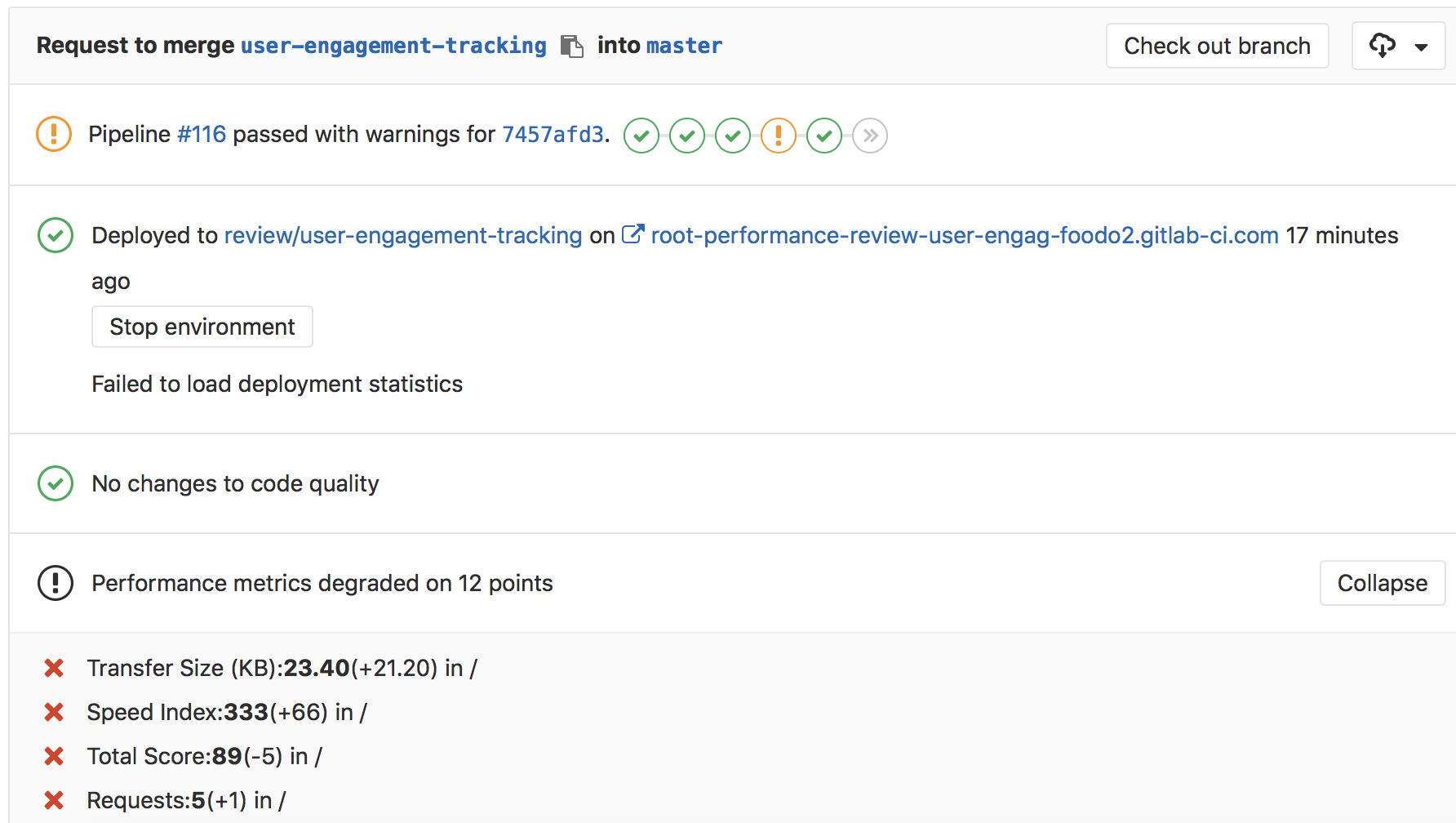8.9 KiB
| type |
|---|
| reference, howto |
Browser Performance Testing (PREMIUM)
Introduced in GitLab Premium 10.3.
If your application offers a web interface and you are using GitLab CI/CD, you can quickly determine the performance impact of pending code changes.
Overview
GitLab uses Sitespeed.io, a free and open source
tool for measuring the performance of web sites, and has built a simple
Sitespeed plugin
which outputs the results in a file called performance.json. This plugin
outputs the performance score for each page that is analyzed.
The Sitespeed.io performance score is a composite value based on best practices, and we will be expanding support for additional metrics in a future release.
Going a step further, GitLab can show the Performance report right in the merge request widget area (see below).
Use cases
For instance, consider the following workflow:
- A member of the marketing team is attempting to track engagement by adding a new tool.
- With browser performance metrics, they see how their changes are impacting the usability of the page for end users.
- The metrics show that after their changes the performance score of the page has gone down.
- When looking at the detailed report, they see that the new JavaScript library was
included in
<head>which affects loading page speed. - They ask a front end developer to help them, who sets the library to load asynchronously.
- The frontend developer approves the merge request and authorizes its deployment to production.
How it works
First of all, you need to define a job in your .gitlab-ci.yml file that generates the
Performance report artifact.
For more information on how the Performance job should look like, check the
example on Testing Browser Performance.
GitLab then checks this report, compares key performance metrics for each page between the source and target branches, and shows the information right on the merge request.
NOTE: Note:
If the Performance report doesn't have anything to compare to, no information
will be displayed in the merge request area. That is the case when you add the
Performance job in your .gitlab-ci.yml for the very first time.
Consecutive merge requests will have something to compare to, and the Performance
report will be shown properly.
Configuring Browser Performance Testing
NOTE: Note: The job definition shown below is supported in GitLab 11.5 and later versions. It also requires GitLab Runner 11.5 or later. For earlier versions, use the previous job definitions.
This example shows how to run the sitespeed.io container on your code by using GitLab CI/CD and sitespeed.io using Docker-in-Docker.
First, you need GitLab Runner with docker-in-docker build.
Once you set up the Runner, add a new job to .gitlab-ci.yml that generates the
expected report:
performance:
stage: performance
image: docker:git
variables:
URL: https://example.com
services:
- docker:stable-dind
script:
- mkdir gitlab-exporter
- wget -O ./gitlab-exporter/index.js https://gitlab.com/gitlab-org/gl-performance/raw/master/index.js
- mkdir sitespeed-results
- docker run --shm-size=1g --rm -v "$(pwd)":/sitespeed.io sitespeedio/sitespeed.io:6.3.1 --plugins.add ./gitlab-exporter --outputFolder sitespeed-results $URL
- mv sitespeed-results/data/performance.json performance.json
artifacts:
paths:
- sitespeed-results/
reports:
performance: performance.json
The above example will create a performance job in your CI/CD pipeline and will run
sitespeed.io against the webpage you defined in URL to gather key metrics.
The GitLab plugin for sitespeed.io
is downloaded in order to save the report as a Performance report artifact
that you can later download and analyze. Due to implementation limitations we always
take the latest Performance artifact available.
The full HTML sitespeed.io report will also be saved as an artifact, and if you have GitLab Pages enabled, it can be viewed directly in your browser.
For further customization options for sitespeed.io, including the ability to provide a list of URLs to test, please see the Sitespeed.io Configuration documentation.
TIP: Tip: Key metrics are automatically extracted and shown in the merge request widget.
Performance testing on Review Apps
The above CI YML is great for testing against static environments, and it can be extended for dynamic environments. There are a few extra steps to take to set this up:
- The
performancejob should run after the dynamic environment has started. - In the
reviewjob, persist the hostname and upload it as an artifact so it's available to theperformancejob (the same can be done for static environments like staging and production to unify the code path). Saving it as an artifact is as simple asecho $CI_ENVIRONMENT_URL > environment_url.txtin your job'sscript. - In the
performancejob, read the previous artifact into an environment variable, like$CI_ENVIRONMENT_URL, and use it to parameterize the test URLs. - You can now run the sitespeed.io container against the desired hostname and paths.
Your .gitlab-ci.yml file would look like:
stages:
- deploy
- performance
review:
stage: deploy
environment:
name: review/$CI_COMMIT_REF_SLUG
url: http://$CI_COMMIT_REF_SLUG.$APPS_DOMAIN
script:
- run_deploy_script
- echo $CI_ENVIRONMENT_URL > environment_url.txt
artifacts:
paths:
- environment_url.txt
only:
- branches
except:
- master
performance:
stage: performance
image: docker:git
services:
- docker:stable-dind
dependencies:
- review
script:
- export CI_ENVIRONMENT_URL=$(cat environment_url.txt)
- mkdir gitlab-exporter
- wget -O ./gitlab-exporter/index.js https://gitlab.com/gitlab-org/gl-performance/raw/master/index.js
- mkdir sitespeed-results
- docker run --shm-size=1g --rm -v "$(pwd)":/sitespeed.io sitespeedio/sitespeed.io:6.3.1 --plugins.add ./gitlab-exporter --outputFolder sitespeed-results "$CI_ENVIRONMENT_URL"
- mv sitespeed-results/data/performance.json performance.json
artifacts:
paths:
- sitespeed-results/
reports:
performance: performance.json
A complete example can be found in our Auto DevOps CI YML.
Previous job definitions
CAUTION: Caution:
Before GitLab 11.5, Performance job and artifact had to be named specifically
to automatically extract report data and show it in the merge request widget.
While these old job definitions are still maintained they have been deprecated
and may be removed in next major release, GitLab 12.0.
You are advised to update your current .gitlab-ci.yml configuration to reflect that change.
For GitLab 11.4 and earlier, the job should look like:
performance:
stage: performance
image: docker:git
variables:
URL: https://example.com
services:
- docker:stable-dind
script:
- mkdir gitlab-exporter
- wget -O ./gitlab-exporter/index.js https://gitlab.com/gitlab-org/gl-performance/raw/master/index.js
- mkdir sitespeed-results
- docker run --shm-size=1g --rm -v "$(pwd)":/sitespeed.io sitespeedio/sitespeed.io:6.3.1 --plugins.add ./gitlab-exporter --outputFolder sitespeed-results $URL
- mv sitespeed-results/data/performance.json performance.json
artifacts:
paths:
- performance.json
- sitespeed-results/
